The decorative masterwort is particularly popular because of its wild perennial character and the extraordinarily filigree flowers. Due to its appearance, it is well suited for loosening up any bed.

Currently lies the masterwort (Astrantia) right on trend and adorns many bouquets. In addition, the perennial tends to multiply and spread itself in suitable locations. In this article you will find out how you can optimally integrate the masterwort in your own garden and what properties it brings with it.
contents
- Masterwort: flowering time, origin and properties
- The most beautiful star umbel varieties
- plant masterwort
-
The right care
- Watering, fertilizing and Co.
- cut starwort
- Is the masterwort hardy?
- propagation
- Is the starwort poisonous?
Masterwort: flowering time, origin and properties
The masterwort is classified in the umbelliferae family (Apiaceae). The best-known species of the genus, the Great Masterwort (
Astrantia major), is known depending on the region as Stränze, Sternblume, Moister, Holznageli or Rietdolden. Of the 9 species of the genus come the Bavarian masterwort (Astrantia bavarica), the Krainer masterwort (Astrantia carniolica), the Large Masterwort and the Small Masterwort (Astrantia minor) in Central Europe. These 4 species are interesting for the culture in our gardens. The natural habitat of the large masterwort includes mountain meadows and tall herb meadows, but also semi-shady woody edges with calcareous, moderately nitrogen-rich, fresh to moist soil.The deciduous, perennial perennials are about 40 to 70 cm high depending on the variety and have a clumpy growth habit. They form tall, bare stalks that branch towards the end and each carry an umbel of flowers. The leaf shapes differ within the genus. The usually glossy green leaves of the Great Masterwort have five to seven parts and are roughly serrated. The basal foliage is usually larger than that on the stem. The numerous flowers of the star flower are assembled in umbels and surrounded by a few radially arranged bracts, which are white, pink or reddish in color depending on the variety. Elongated split fruits develop from the fertilized flowers.
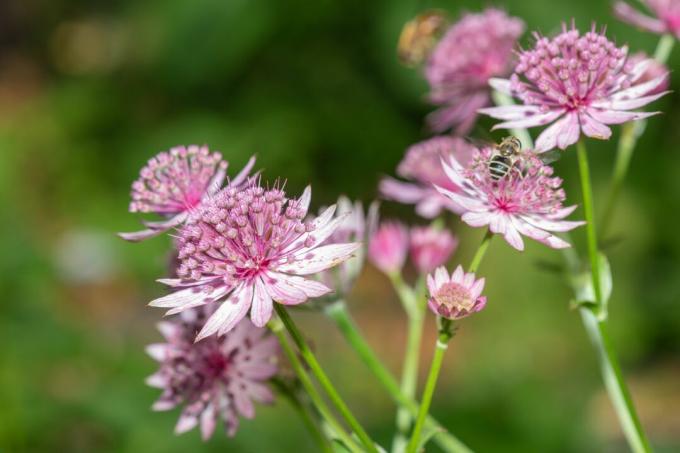
The entire insect visit of the masterwort is relatively sparse. After all, a wide variety of insects from butterflies to bees and flies to beetles can be observed on the masterwort. The latter are the main pollinators of the flowers. The masterwort is also an important food plant for the caterpillars of two butterfly species.
When does the masterwort bloom? Depending on the species, the flowering period of the masterwort begins as early as May and extends into September due to the reblooming behavior. So you can look at the beautiful sight of the for a very long time Astrantia delight.
The most beautiful star umbel varieties
There are a variety of different colored varieties of star umbels, which are from the species Astrantia major emerge. The most beautiful and proven of these are presented below. Most of the varieties mentioned bloom from June to July and again in September.
- Astrantia major ˈAbbey Roadˈ: The flowers of this variety are dark purple. It reaches a height of 60 - 70 cm and is one of the best of the new star umbel varieties.
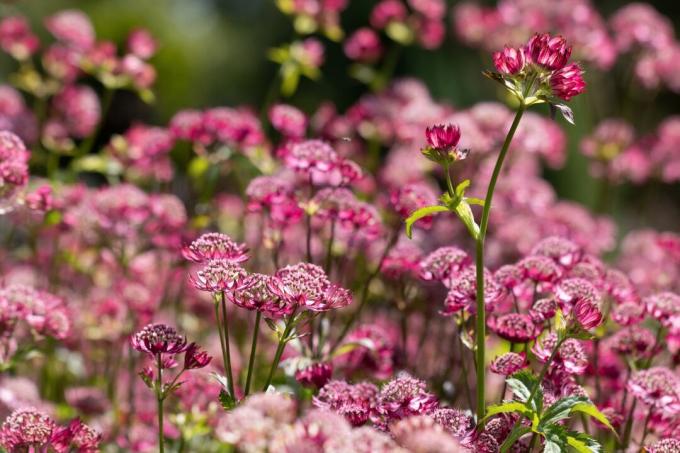
- Astrantia major ˈSunningdale Variegatedˈ: The special feature here is the cream-colored markings on the leaves, which change over the course of the year. The flowers appear in a delicate white-pink tone. The growth height is also 60 - 70 cm.

- Astrantia major ˈMoulin Rougeˈ: The crimson bracts of ˈMoulin Rougeˈ have purple-violet tips. This variety is not only an excellent bedding perennial, but also convinces with an excellent cutting quality. It reaches a height of 40 - 50 cm.
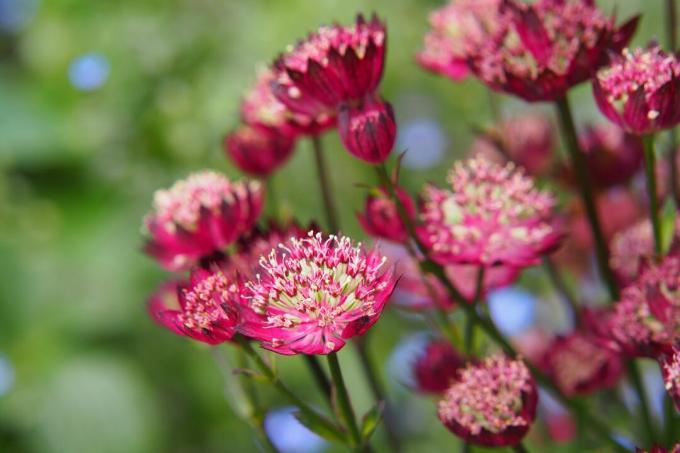
- Astrantia major ˈShaggyˈ: This masterwort is also under the name ˈMargery Fishˈ known and bears silvery-white flower heads whose bracts have greenish tips. It grows about 50-60 cm high.
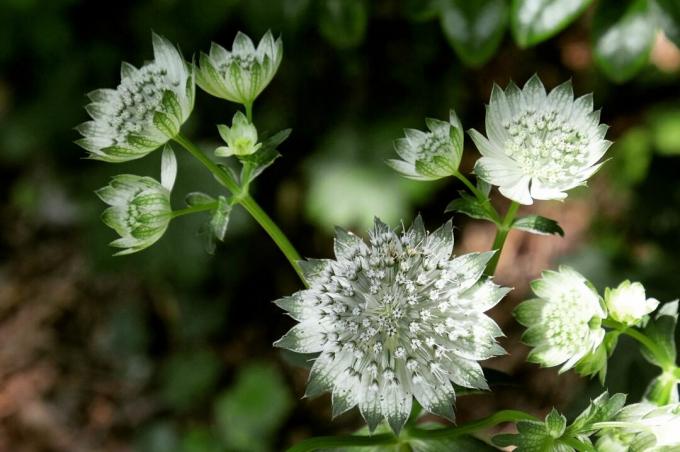
- Astrantia major ˈRomaˈ: The flower coloring of this variety is very multifaceted and varies from old pink to silvery pink to bright pink. Their growth height is about 40 - 60 cm.

- Astrantia major ˈFlorenceˈ: The flowers of this unusual and plentiful variety are silvery, pink and lavender in colour. It also reaches 40 - 60 cm.
- Astrantia major ˈElm Bloodˈ: The variety is characterized by a rather compact growth with a height of about 40 cm and has beautiful, bright wine-red flowers.
plant masterwort
Before planting the masterwort, a suitable location must be found that meets the needs of the umbelliferae. Areas of life where the perennials feel comfortable are light wooded edges and moist outdoor areas. The soil should be constantly fresh to moist and preferably rich in lime or at least neutral and moderately rich in nutrients. Loamy, humus-rich soils are suitable, for example, because of their good water storage capacity. The masterwort copes well with the root penetration of the soil by neighboring plants. The location should be in the sun or semi-shade - avoid full sun. As far as socializing is concerned, the star flower can be planted in smaller groups of around 3 to 10 plants, keeping a distance of around 45 cm between them.
Outdoors, the masterwort is either sown in autumn or planted between April and May. If you cultivate the young plants yourself, there are a few things to consider. Since these perennials are cold germs, they require cold treatment for germination. It therefore makes the most sense to either sow the seeds directly outdoors or to prefer them in pots in a sheltered spot from February onwards. For sowing in pots, it is best to use high-quality seed soil, which is mixed with a little lime for optimal conditions. For example, ours is suitable for this Plantura Organic Herb & Seed Soil ideal, which, with the optimally balanced nutrient ratio, ensures strong young plants with pronounced root growth. For the next steps, proceed as follows:

Plantura Organic Herb & Seed Soil
Organic, peat-free & climate-friendly:
For aromatic herbs and for
successful sowing, cuttings
propagation & for pricking out
- Sow outdoors in autumn or March
- Pour the lime-seeding soil mixture into the seed tray or pots
- Press the substrate lightly and distribute several or one seed per pot
- Do not cover the seeds of the light germinator with soil
- Keep substrate moist
- germination after approx. 4 - 6 weeks at temperatures of 5 - 12 °C
- Prick out several closely seeded plants at the cotyledon stage
- Plant out strong young plants with a well-developed root system

Combine starwort: The masterwort can be combined with many partners in partially shaded beds. The combination with hosts (hosta), lady's mantle (Alchemilla), Bergenia (Bergenia), the splendor pier (astilbe) or the thimble (digitalis) creates a beautiful overall picture.
The right care
The care measures of the masterwort do not pose a great challenge and are uncomplicated. The better the location is tailored to the needs of the plant, the less complex the care will be.
Watering, fertilizing and Co.
In a sunny location and especially on light soil, the masterwort must be watered very regularly, as it needs a consistently slightly moist substrate. Therefore, sufficient watering should be ensured on hot days.
With a one-off application of compost or fertilizer in the spring, you can supply the masterwort with essential nutrients. Since the perennial has only a moderate nutrient requirement, further fertilization is not necessary. If you don't have or can't source compost, ours is for example Plantura organic flower fertilizer a good choice. Its primarily organic composition ensures slow release of nutrients and maintains soil fertility.
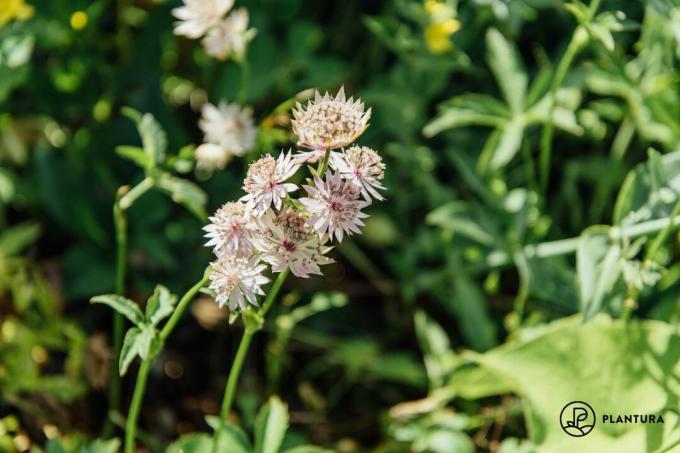
cut starwort
A cut is not absolutely necessary for the star umbel. In order to achieve a rebloom in September, however, you can cut back the old inflorescences directly after the first flowering period. The withered inflorescences should generally be removed if you want to prevent the masterwort from becoming overgrown by seeding.
The high floristic value of the star umbels is also worth mentioning: the enchanting blossoms are excellent cut flowers and complement every summer bouquet with their extravagance.
Is the masterwort hardy?
The star umbels are assigned to the winter hardiness zone Z6. This means they can withstand temperatures down to around – 23 °C. In harder winters, slight damage can occur, which is why a sheltered location is always chosen for the perennial. Nothing can happen to the masterwort if it is covered with leaves or brushwood.
propagation
Propagating the masterwort is an uncomplicated matter, because the perennial usually takes care of the propagation itself if the inflorescences are left standing. However, if you want to multiply the plant in a targeted manner, you can do so either by sowing or dividing the masterwort. It must be noted here that the young plants propagated by sowing need more time until they develop strong perennials with a rich flower base.
The seeds of the masterwort are harvested in autumn on a dry day. The further procedure for sowing is the same as described above.

The division of the perennial takes place in the spring. For this, the root ball is carefully dug up and exposed. Now the plant is divided with a spade, for example, and the individual pieces are replanted and watered with the planting distance maintained.
Tip: The seedlings are usually not varietal. For varietal propagation, the perennial must be divided in spring in order to obtain young plants of the same variety in the following year.
Is the starwort poisonous?
The masterwort contains ingredients such as rosmarinic acid, flavonoids, flavonol glycosides and saponins. With these substances, the tolerance or the occurrence of symptoms of poisoning is very much dependent on the quantity. The saponins are only contained in a minimal proportion of 0.1 to 0.2%.
Due to the healing effect of the masterwort on respiratory diseases, wounds and bleeding in the gastrointestinal tract, the plant is even used in folk medicine.
However, the consumption of larger amounts by humans and animals is definitely not recommended.
Because of its self-seeding ability and tendency to naturalize, the masterwort is an ideal candidate for this Black box gardening. You can read in our special article what exactly this is and how best to implement the concept.
...and receive concentrated plant knowledge and inspiration directly in your e-mail inbox every Sunday!
